
《英美税务导论(英)》课程教学大纲 一、课程基本信息 课程代码:16014802 课程名称:英美税务导论(英) 英文名称:Introduction to US and UK Taxation 课程类别:专业课 时:32 学分:2 适用对象:商务英语专业本科生 考核方式:考试 先修课程:当代商学概论(英)、经济数学 二、课程简介 《英美税务导论(英)》是为外国语学院商务英语专业方向学生开设的专业基础 必修课。作为税收方向的一门入门级课程,本课程需要当代商学概论、经济数学等前 期课程作为基础,其内容主要包括介绍英美国家的税收基本制度和规则,着重以英国 税法为例,具体介绍英语税法中的个人所得税、增值税、遗产税、国民生产税以及相 关的基本税收征管方式。通过该门课程的学习,要求学生对国际税收的基本知识、基 本英文专业术语等有一个初步的了解,能够阅读税法方面的英文文献。 Introduction to US and UK Taxation is one of the compulsive courses for business English majors.As an introduction course to taxation,it needs the previous study of some course like Introduction to Contemporary Business and Mathematics of Economics as the foundation.Its scope of contents includes the very basic knowledge and conceptions on US and UK taxation systems and regulations,mainly focusing on UK's individual income tax, VAT,inheritance tax,national insurance contribution and the relevant tax administrations. Through the study of this course,the students are required to know the basic knowledge about taxation and English expression concerning taxation expressions,and they also can read most ofthe articles on taxation in English 三、课程性质与教学目的 本课程是商务英语专业的主干课程之一。本课程的主要任务和目标:通过本课程 的学习,使学生能够基本了解和掌握英美国家现行的税收法律规定及实务操作方法能 够阅读税收方面的英文文献,并且形成一定的税收意识
1 《英美税务导论(英)》课程教学大纲 一、课程基本信息 课程代码:16014802 课程名称:英美税务导论(英) 英文名称:Introduction to US and UK Taxation 课程类别:专业课 学 时:32 学 分:2 适用对象:商务英语专业本科生 考核方式:考试 先修课程:当代商学概论(英)、经济数学 二、课程简介 《英美税务导论(英)》是为外国语学院商务英语专业方向学生开设的专业基础 必修课。作为税收方向的一门入门级课程,本课程需要当代商学概论、经济数学等前 期课程作为基础,其内容主要包括介绍英美国家的税收基本制度和规则,着重以英国 税法为例,具体介绍英语税法中的个人所得税、增值税、遗产税、国民生产税以及相 关的基本税收征管方式。通过该门课程的学习,要求学生对国际税收的基本知识、基 本英文专业术语等有一个初步的了解,能够阅读税法方面的英文文献。 Introduction to US and UK Taxation is one of the compulsive courses for business English majors. As an introduction course to taxation, it needs the previous study of some course like Introduction to Contemporary Business and Mathematics of Economics as the foundation. Its scope of contents includes the very basic knowledge and conceptions on US and UK taxation systems and regulations, mainly focusing on UK’s individual income tax, VAT, inheritance tax, national insurance contribution and the relevant tax administrations. Through the study of this course, the students are required to know the basic knowledge about taxation and English expression concerning taxation expressions, and they also can read most of the articles on taxation in English 三、课程性质与教学目的 本课程是商务英语专业的主干课程之一。本课程的主要任务和目标:通过本课程 的学习,使学生能够基本了解和掌握英美国家现行的税收法律规定及实务操作方法能 够阅读税收方面的英文文献,并且形成一定的税收意识
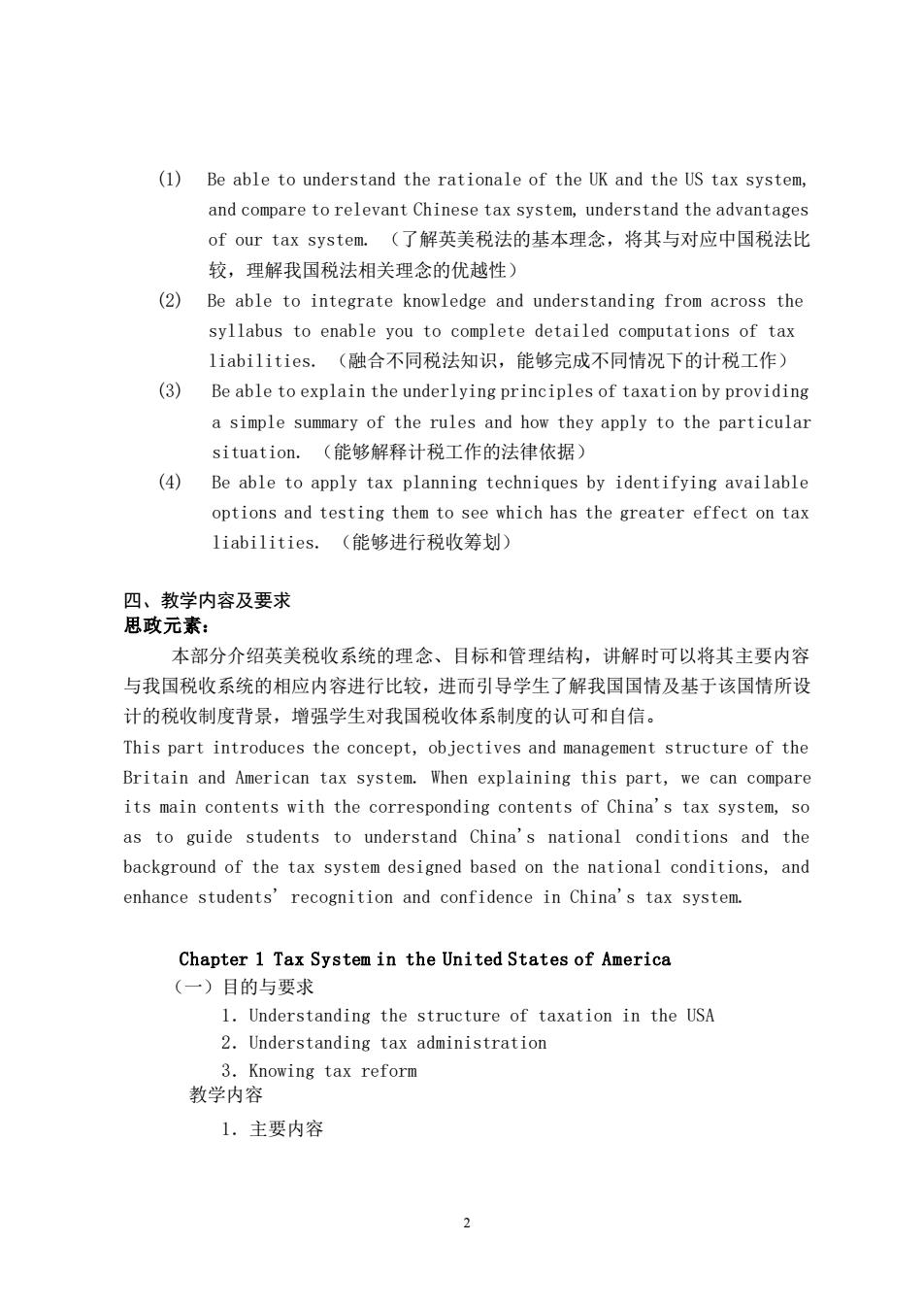
(1)Be able to understand the rationale of the UK and the US tax system, and compare to relevant Chinese tax system,understand the advantages of our tax system..(了解英美税法的基本理念,将其与对应中国税法比 较,理解我国税法相关理念的优越性) (2)Be able to integrate knowledge and understanding from across the syllabus to enable you to complete detailed computations of tax liabilities..(融合不同税法知识,能够完成不同情况下的计税工作) (3)Be able to explain the underlying principles of taxation by providing a simple summary of the rules and how they apply to the particular situation.(能够解释计税工作的法律依据) (4)Be able to apply tax planning techniques by identifying available options and testing them to see which has the greater effect on tax liabilities.(能够进行税收筹划) 四、教学内容及要求 思政元素: 本部分介绍英美税收系统的理念、目标和管理结构,讲解时可以将其主要内容 与我国税收系统的相应内容进行比较,进而引导学生了解我国国情及基于该国情所设 计的税收制度背景,增强学生对我国税收体系制度的认可和自信。 This part introduces the concept,objectives and management structure of the Britain and American tax system.When explaining this part,we can compare its main contents with the corresponding contents of China's tax system,so as to guide students to understand China's national conditions and the background of the tax system designed based on the national conditions,and enhance students'recognition and confidence in China's tax system. Chapter 1 Tax System in the United States of America (一)目的与要求 1.Understanding the structure of taxation in the USA 2.Understanding tax administration 3.Knowing tax reform 教学内容 1.主要内容
2 (1) Be able to understand the rationale of the UK and the US tax system, and compare to relevant Chinese tax system, understand the advantages of our tax system. (了解英美税法的基本理念,将其与对应中国税法比 较,理解我国税法相关理念的优越性) (2) Be able to integrate knowledge and understanding from across the syllabus to enable you to complete detailed computations of tax liabilities. (融合不同税法知识,能够完成不同情况下的计税工作) (3) Be able to explain the underlying principles of taxation by providing a simple summary of the rules and how they apply to the particular situation. (能够解释计税工作的法律依据) (4) Be able to apply tax planning techniques by identifying available options and testing them to see which has the greater effect on tax liabilities. (能够进行税收筹划) 四、教学内容及要求 思政元素: 本部分介绍英美税收系统的理念、目标和管理结构,讲解时可以将其主要内容 与我国税收系统的相应内容进行比较,进而引导学生了解我国国情及基于该国情所设 计的税收制度背景,增强学生对我国税收体系制度的认可和自信。 This part introduces the concept, objectives and management structure of the Britain and American tax system. When explaining this part, we can compare its main contents with the corresponding contents of China's tax system, so as to guide students to understand China's national conditions and the background of the tax system designed based on the national conditions, and enhance students' recognition and confidence in China's tax system. Chapter 1 Tax System in the United States of America (一)目的与要求 1.Understanding the structure of taxation in the USA 2.Understanding tax administration 3.Knowing tax reform 教学内容 1.主要内容

1.1 Overview of the federal tax system 1.2 Main federal taxes 1.3 State taxes 1.4 Local government taxes 2.1 Federal administration 2.2 State administrations 2.3 Local administrations 2.基本概念和知识点 Individual income tax Corporate income tax Payroll taxes Estate and gift and generation-skipping transfer taxes State income tax State sales taxes Property tax International revenue service Examination Published and private rulings Alcohol and tobacco tax and trade bureau Customs and border protection 3.问题与应用(能力要求) Answer the following questions 1.Please briefly analyze the characteristics of tax system in the US. 2.Introduce the classification of the taxpayers of Individual Income Tax in the US. 3.Talk about the sales tax in the US.And make a comparison between sales tax in the US and VAT in China. 4.Make a comparison of the system structure between China and the US. 5.Please think about the main differences of the levying model of individual income tax between China and the US. (三)思考与实践 Explain the following sentences 1.Taxes are imposed on net income of individuals and corporations by
3 1.1 Overview of the federal tax system 1.2 Main federal taxes 1.3 State taxes 1.4 Local government taxes 2.1 Federal administration 2.2 State administrations 2.3 Local administrations 2.基本概念和知识点 Individual income tax Corporate income tax Payroll taxes Estate and gift and generation-skipping transfer taxes State income tax State sales taxes Property tax International revenue service Examination Published and private rulings Alcohol and tobacco tax and trade bureau Customs and border protection 3.问题与应用(能力要求) Answer the following questions 1.Please briefly analyze the characteristics of tax system in the US. 2.Introduce the classification of the taxpayers of Individual Income Tax in the US. 3.Talk about the sales tax in the US. And make a comparison between sales tax in the US and VAT in China. 4.Make a comparison of the system structure between China and the US. 5.Please think about the main differences of the levying model of individual income tax between China and the US. (三)思考与实践 Explain the following sentences 1.Taxes are imposed on net income of individuals and corporations by
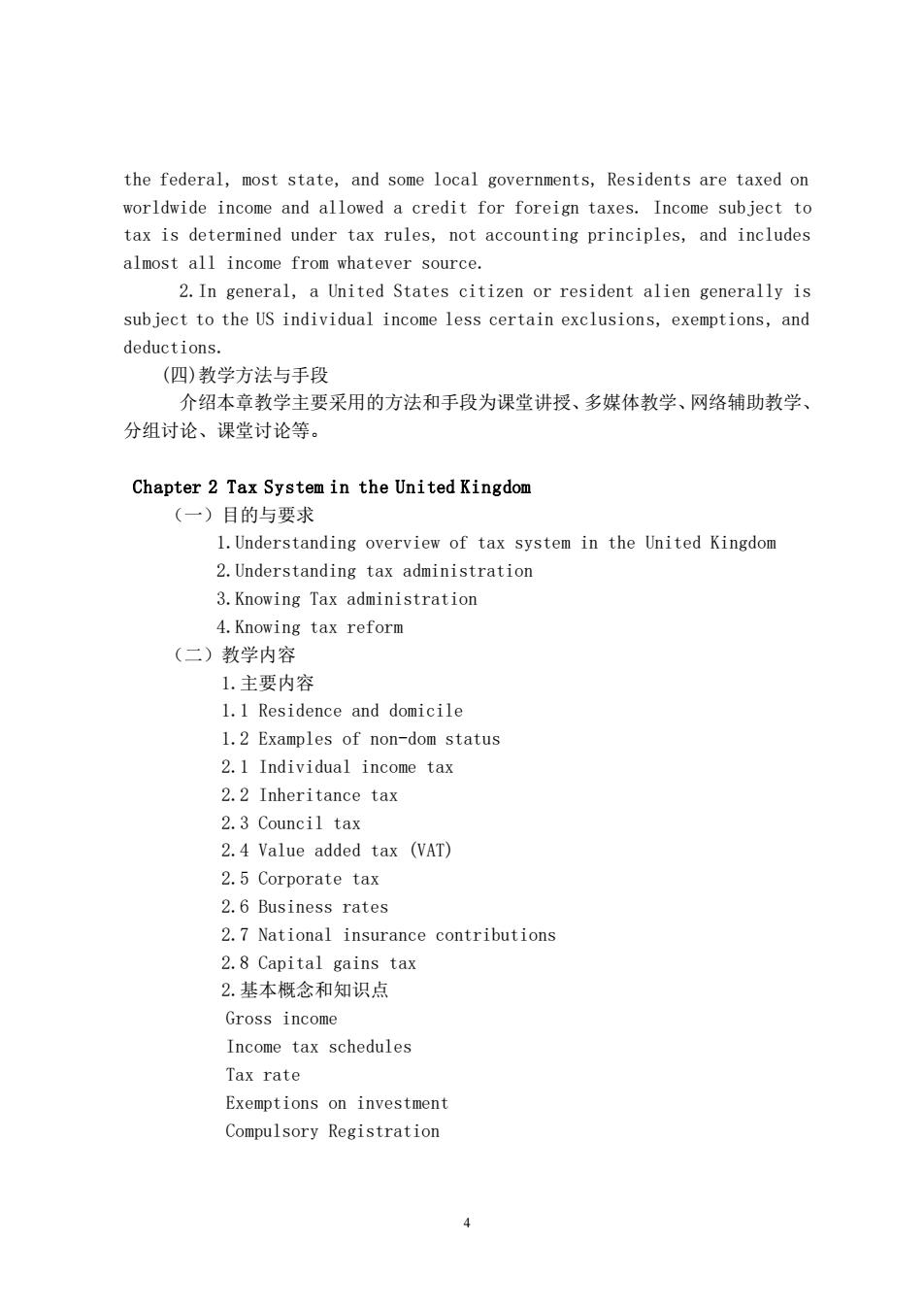
the federal,most state,and some local governments,Residents are taxed on worldwide income and allowed a credit for foreign taxes.Income subject to tax is determined under tax rules,not accounting principles,and includes almost all income from whatever source. 2.In general.a United States citizen or resident alien generally is subject to the US individual income less certain exclusions,exemptions,and deductions. (四)教学方法与手段 介绍本章教学主要采用的方法和手段为课堂讲授、多媒体教学、网络辅助教学、 分组讨论、课堂讨论等 Chapter 2 Tax System in the United Kingdom (一)目的与要求 1.Understanding overview of tax system in the United Kingdom 2.Understanding tax administration 3.Knowing Tax administration 4.Knowing tax reform (二)教学内容 1.主要内容 1.1 Residence and domicile 1.2 Examples of non-dom status 2.1 Individual income tax 2.2 Inheritance tax 2.3 Council tax 2.4 Value added tax (VAT) 2.5 Corporate tax 2.6 Business rates 2.7 National insurance contributions 2.8 Capital gains tax 2.基本概念和知识点 Gross income Income tax schedules Tax rate Exemptions on investment Compulsory Registration
4 the federal, most state, and some local governments, Residents are taxed on worldwide income and allowed a credit for foreign taxes. Income subject to tax is determined under tax rules, not accounting principles, and includes almost all income from whatever source. 2.In general, a United States citizen or resident alien generally is subject to the US individual income less certain exclusions, exemptions, and deductions. (四)教学方法与手段 介绍本章教学主要采用的方法和手段为课堂讲授、多媒体教学、网络辅助教学、 分组讨论、课堂讨论等。 Chapter 2 Tax System in the United Kingdom (一)目的与要求 1.Understanding overview of tax system in the United Kingdom 2.Understanding tax administration 3.Knowing Tax administration 4.Knowing tax reform (二)教学内容 1.主要内容 1.1 Residence and domicile 1.2 Examples of non-dom status 2.1 Individual income tax 2.2 Inheritance tax 2.3 Council tax 2.4 Value added tax (VAT) 2.5 Corporate tax 2.6 Business rates 2.7 National insurance contributions 2.8 Capital gains tax 2.基本概念和知识点 Gross income Income tax schedules Tax rate Exemptions on investment Compulsory Registration
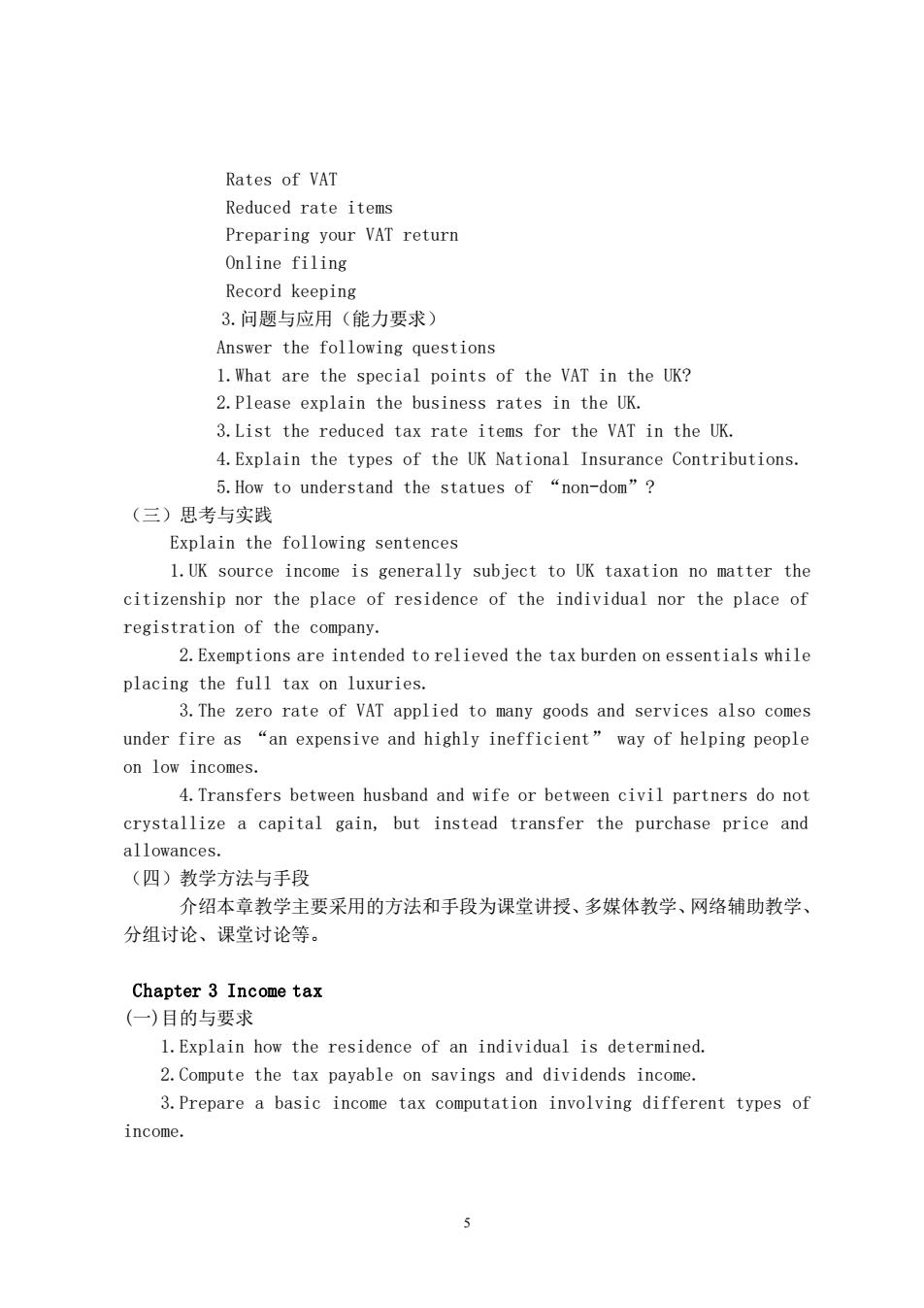
Rates of VAT Reduced rate items Preparing your VAT return Online filing Record keeping 3.问题与应用(能力要求) Answer the following questions 1.What are the special points of the VAT in the UK? 2.Please explain the business rates in the UK. 3.List the reduced tax rate items for the VAT in the UK. 4.Explain the types of the UK National Insurance Contributions. 5.How to understand the statues of“non-dom”? (三)思考与实践 Explain the following sentences 1.UK source income is generally subject to UK taxation no matter the citizenship nor the place of residence of the individual nor the place of registration of the company. 2.Exemptions are intended to relieved the tax burden on essentials while placing the full tax on luxuries. 3.The zero rate of VAT applied to many goods and services also comes under fire as "an expensive and highly inefficient"way of helping people on low incomes. 4.Transfers between husband and wife or between civil partners do not crystallize a capital gain,but instead transfer the purchase price and allowances. (四)教学方法与手段 介绍本章教学主要采用的方法和手段为课堂讲授、多媒体教学、网络辅助教学、 分组讨论、课堂讨论等。 Chapter 3 Income tax (一)目的与要求 1.Explain how the residence of an individual is determined. 2.Compute the tax payable on savings and dividends income. 3.Prepare a basic income tax computation involving different types of income. 5
5 Rates of VAT Reduced rate items Preparing your VAT return Online filing Record keeping 3.问题与应用(能力要求) Answer the following questions 1.What are the special points of the VAT in the UK? 2.Please explain the business rates in the UK. 3.List the reduced tax rate items for the VAT in the UK. 4.Explain the types of the UK National Insurance Contributions. 5.How to understand the statues of “non-dom”? (三)思考与实践 Explain the following sentences 1.UK source income is generally subject to UK taxation no matter the citizenship nor the place of residence of the individual nor the place of registration of the company. 2.Exemptions are intended to relieved the tax burden on essentials while placing the full tax on luxuries. 3.The zero rate of VAT applied to many goods and services also comes under fire as “an expensive and highly inefficient” way of helping people on low incomes. 4.Transfers between husband and wife or between civil partners do not crystallize a capital gain, but instead transfer the purchase price and allowances. (四)教学方法与手段 介绍本章教学主要采用的方法和手段为课堂讲授、多媒体教学、网络辅助教学、 分组讨论、课堂讨论等。 Chapter 3 Income tax (一)目的与要求 1.Explain how the residence of an individual is determined. 2.Compute the tax payable on savings and dividends income. 3.Prepare a basic income tax computation involving different types of income

4.Calculate the amount of personal allowance available. 5.Understand the impact of the transferable amount of personal allowance for spouses and civil partners. 6.Compute the amount of income tax payable. 7.Explain the treatment of interest paid for a qualifying purpose. 8.Understanding the treatment of gift donations and charitable giving. 9.Explain and compute the child benefit tax charge. 10.Understand the treatment of property owned jointly by a married couple, or by a couple in a civil partnership. 11.Understand how a married couple or a couple in a civil partnership can minimize their tax liabilities. 12.Basic income tax planning. 13.Recognise the factors that determine whether an engagement is treated as employment or self-employment. 14.Recognise the basis of assessment for employment income 15.Recognise the income assessable. 16.Recognise the allowable deductions,including traveling expenses 17.Discuss the use of the statutory approved mileage allowances. 18.Understand the treatment of charitable giving. 19.Explain the PAYE system,how benefits can be payrolled,and the purpose of form Pl1D. 20.Explain and compute the amount of benefits assessable. 21.Recongnise the circumstances in which real time reporting late filling penalties will be imposed on an employer and the amount of penalty which is charged. 22.Explain and compute the relief given for contributions to personal pension schemes and to occupational pension schemes. 23.Compute property business profits. 24.Explain the treatment of furnished holiday lettings. 25.Understand rent-a-room relief. 26.Compute the amount assessable when a premium is received for the grant of a short lease. 27.Understand how relief for a property business loss is given. 28.Describe and apply the badges of trade. 29.Recognise the expenditure that is allowable in calculating the 6
6 4.Calculate the amount of personal allowance available. 5.Understand the impact of the transferable amount of personal allowance for spouses and civil partners. 6.Compute the amount of income tax payable. 7.Explain the treatment of interest paid for a qualifying purpose. 8.Understanding the treatment of gift donations and charitable giving. 9.Explain and compute the child benefit tax charge. 10.Understand the treatment of property owned jointly by a married couple, or by a couple in a civil partnership. 11.Understand how a married couple or a couple in a civil partnership can minimize their tax liabilities. 12.Basic income tax planning. 13.Recognise the factors that determine whether an engagement is treated as employment or self-employment. 14.Recognise the basis of assessment for employment income. 15.Recognise the income assessable. 16.Recognise the allowable deductions, including traveling expenses. 17.Discuss the use of the statutory approved mileage allowances. 18.Understand the treatment of charitable giving. 19.Explain the PAYE system, how benefits can be payrolled, and the purpose of form P11D. 20.Explain and compute the amount of benefits assessable. 21.Recongnise the circumstances in which real time reporting late filling penalties will be imposed on an employer and the amount of penalty which is charged. 22.Explain and compute the relief given for contributions to personal pension schemes and to occupational pension schemes. 23.Compute property business profits. 24.Explain the treatment of furnished holiday lettings. 25.Understand rent-a-room relief. 26.Compute the amount assessable when a premium is received for the grant of a short lease. 27.Understand how relief for a property business loss is given. 28.Describe and apply the badges of trade. 29.Recognise the expenditure that is allowable in calculating the
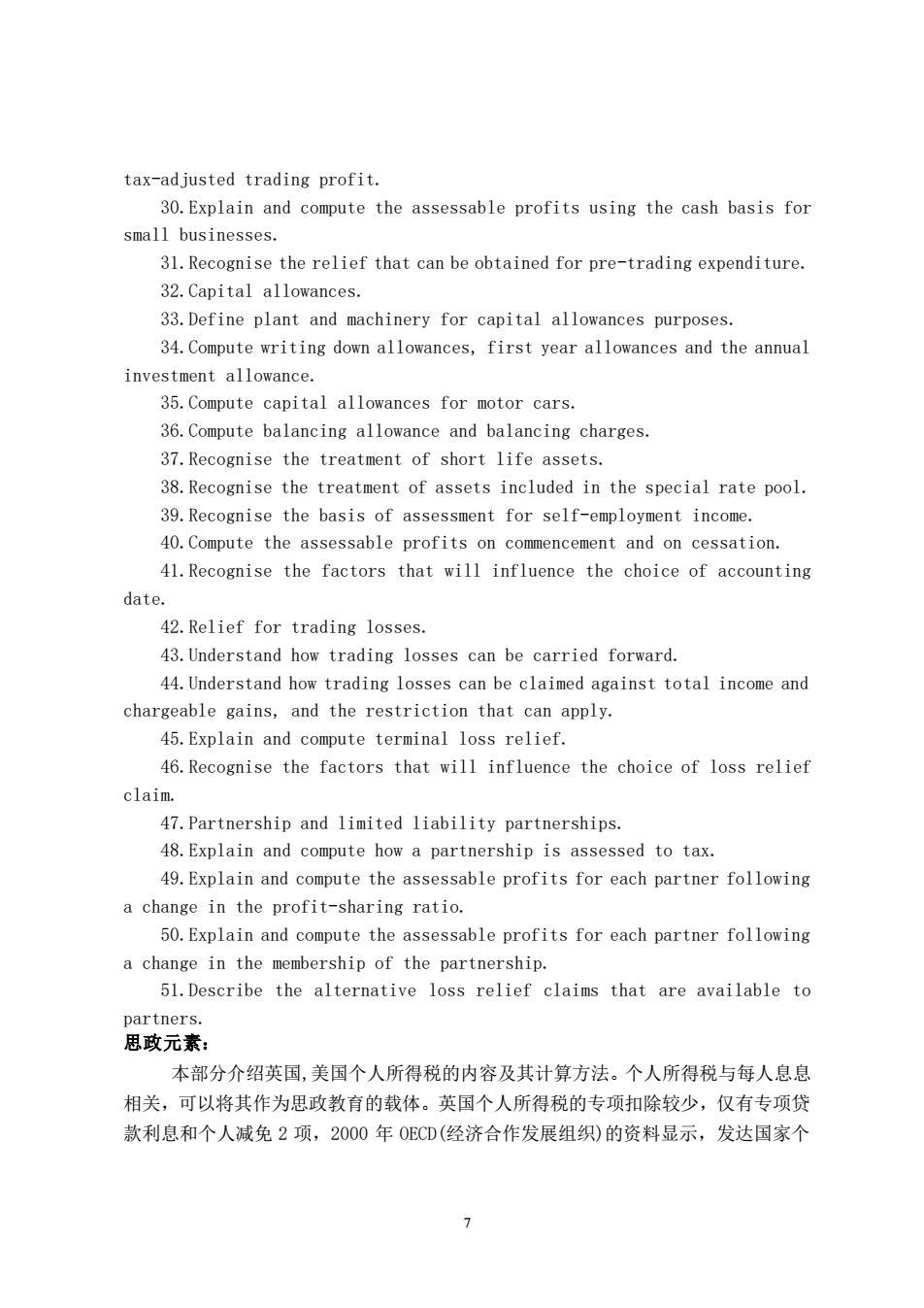
tax-adjusted trading profit. 30.Explain and compute the assessable profits using the cash basis for small businesses. 31.Recognise the relief that can be obtained for pre-trading expenditure. 32.Capital allowances. 33.Define plant and machinery for capital allowances purposes. 34.Compute writing down allowances,first year allowances and the annual investment allowance. 35.Compute capital allowances for motor cars. 36.Compute balancing allowance and balancing charges. 37.Recognise the treatment of short life assets. 38.Recognise the treatment of assets included in the special rate pool. 39.Recognise the basis of assessment for self-employment income. 40.Compute the assessable profits on commencement and on cessation. 41.Recognise the factors that will influence the choice of accounting date 42.Relief for trading losses. 43.Understand how trading losses can be carried forward. 44.Understand how trading losses can be claimed against total income and chargeable gains,and the restriction that can apply. 45.Explain and compute terminal loss relief. 46.Recognise the factors that will influence the choice of loss relief claim. 47.Partnership and limited liability partnerships. 48.Explain and compute how a partnership is assessed to tax. 49.Explain and compute the assessable profits for each partner following a change in the profit-sharing ratio. 50.Explain and compute the assessable profits for each partner following a change in the membership of the partnership. 51.Describe the alternative loss relief claims that are available to partners. 思政元素: 本部分介绍英国,美国个人所得税的内容及其计算方法。个人所得税与每人息息 相关,可以将其作为思政教育的载体。英国个人所得税的专项扣除较少,仅有专项贷 款利息和个人减免2项,2000年0ECD(经济合作发展组织)的资料显示,发达国家个 7
7 tax-adjusted trading profit. 30.Explain and compute the assessable profits using the cash basis for small businesses. 31.Recognise the relief that can be obtained for pre-trading expenditure. 32.Capital allowances. 33.Define plant and machinery for capital allowances purposes. 34.Compute writing down allowances, first year allowances and the annual investment allowance. 35.Compute capital allowances for motor cars. 36.Compute balancing allowance and balancing charges. 37.Recognise the treatment of short life assets. 38.Recognise the treatment of assets included in the special rate pool. 39.Recognise the basis of assessment for self-employment income. 40.Compute the assessable profits on commencement and on cessation. 41.Recognise the factors that will influence the choice of accounting date. 42.Relief for trading losses. 43.Understand how trading losses can be carried forward. 44.Understand how trading losses can be claimed against total income and chargeable gains, and the restriction that can apply. 45.Explain and compute terminal loss relief. 46.Recognise the factors that will influence the choice of loss relief claim. 47.Partnership and limited liability partnerships. 48.Explain and compute how a partnership is assessed to tax. 49.Explain and compute the assessable profits for each partner following a change in the profit-sharing ratio. 50.Explain and compute the assessable profits for each partner following a change in the membership of the partnership. 51.Describe the alternative loss relief claims that are available to partners. 思政元素: 本部分介绍英国,美国个人所得税的内容及其计算方法。个人所得税与每人息息 相关,可以将其作为思政教育的载体。英国个人所得税的专项扣除较少,仅有专项贷 款利息和个人减免 2 项,2000 年 OECD(经济合作发展组织)的资料显示,发达国家个

人所得税占国家税收收入总额的平均比重达到29%,若把社会保险税考虑进来,这个 比重则高达51%。税收是美国政府赖以生存的财政基础,而个人所得税则是美国政府 财政的重要来源。而我国个人所得税有6项专项扣除,包括子女教育、继续教育、大 病医疗、住房贷款利息、住房租金和赡养老人。组织学生对上述差异进行讨论,了解 我因个人所得税制度普惠人民的基本理念,增强对我国税收制度的自信。 This part introduces the content and calculation method of personal income tax in the United Kingdom and the United States.Personal income tax is closely concerned with everyone,so it can be used as the carrier of Ideological and political education.The special deduction of personal income tax in the UK is relatively small.There are only two items,like special loan interest and personal deduction.According to the data of OECD in 2000,the average proportion of personal income tax in the total national tax revenue in developed countries is 29%.If social insurance tax is taken into account the proportion is as high as 51%.Tax is the financial basis for the survival of the U.S.government,and personal income tax is an important source of U.S. government finance.In China,there are six special deductions for personal income tax,including children's education,continuing education,serious illness medical care,housing loan interest,housing rent and supporting the elderly.By organizing students to discuss the above differences,they can understand the basic idea of the individual income tax system of our country to benefit the people,and enhance the confidence of our tax system. (二)教学内容 1.主要内容 1.Computing taxable income and the income tax liability 2.Employment income 3.Taxable and exempt benefits.The PAYE system 4.Pensions 5.Property income 6.Computing trading income 7.Capital allowances 8.Assessable trading income 9.trading losses 10.Partnerships and limited liability partnerships 8
8 人所得税占国家税收收入总额的平均比重达到 29%,若把社会保险税考虑进来,这个 比重则高达 51%。税收是美国政府赖以生存的财政基础,而个人所得税则是美国政府 财政的重要来源。而我国个人所得税有 6 项专项扣除,包括子女教育、继续教育、大 病医疗、住房贷款利息、住房租金和赡养老人。组织学生对上述差异进行讨论,了解 我国个人所得税制度普惠人民的基本理念,增强对我国税收制度的自信。 This part introduces the content and calculation method of personal income tax in the United Kingdom and the United States. Personal income tax is closely concerned with everyone, so it can be used as the carrier of Ideological and political education. The special deduction of personal income tax in the UK is relatively small. There are only two items,like special loan interest and personal deduction. According to the data of OECD in 2000, the average proportion of personal income tax in the total national tax revenue in developed countries is 29%. If social insurance tax is taken into account, the proportion is as high as 51%. Tax is the financial basis for the survival of the U.S. government, and personal income tax is an important source of U.S. government finance. In China, there are six special deductions for personal income tax, including children's education, continuing education, serious illness medical care, housing loan interest, housing rent and supporting the elderly. By organizing students to discuss the above differences, they can understand the basic idea of the individual income tax system of our country to benefit the people, and enhance the confidence of our tax system. (二)教学内容 1.主要内容 1.Computing taxable income and the income tax liability 2. Employment income 3. Taxable and exempt benefits. The PAYE system 4. Pensions 5. Property income 6.Computing trading income 7.Capital allowances 8.Assessable trading income 9.trading losses 10.Partnerships and limited liability partnerships

2.基本概念和知识点 Scope of income tax:Computing taxable income;Types of income:Deductible interest:Personal allowance;Computing income tax liability and income tax payable;Accrued income scheme;Gift aid;Child benefit income tax charge: Transferable personal allowance Married couples and coupes in a civil partnership:Employment and self employment:Basic of assessment for employment income:Allowance deductions:Statutory approved mileage allowances:Charitable donations under the payroll deduction scheme:Taxable benefits:Exempt benefits:The PAYE system:Types of pension scheme and membership:Contributing to a pension scheme;Receiving benefits from pension arrangements;Property business income:Furnished holiday lettings:Rent a room relief:Premiums on leases;Property business losses;The benefits of trade:The adjustment of profits;Cash basis of accounting for small businesses Pre-trading expenditure;Capital allowances in general:Plant and machinery-qualifying expenditure:The main pool:Special rate pool:private use assets;Motor cars;Short life assets;Recognize the basis of assessment; Commencement and cessation:The choice of an accounting date:Losses:Carry forward trade loss relief;Trade loss relief against general income;Losses in the early years of a trade:Terminal trade loss relief;Assessment of partnerships to tax;Change in profit sharing ratios;Change in membership of partnership;Loss reliefs for partners; 3.问题与应用(能力要求) 1.If an individual meets none of the automatic overseas tests and none of the automatic UK tests of residence in a tax year,what determines whether the individual is resident in the UK? 2.Give one type of savings income that is received by individuals net of 20%tax. 3.On what basis are earnings taxed? 4.In what circumstances can the cost of home to workplace travel be a qualifying travel expense? 5.What accommodation does not give rise to a taxable benefit? 6.When may an employee who is provided with fuel by his employer avoid a fuel benefit? 7.Jim because a member of a pension scheme for the first time in 2016/17.His only income in 2016/17 is trading income of E163,000.What is Jim's annual
9 2.基本概念和知识点 Scope of income tax; Computing taxable income; Types of income; Deductible interest; Personal allowance; Computing income tax liability and income tax payable; Accrued income scheme; Gift aid; Child benefit income tax charge; Transferable personal allowance ;Married couples and coupes in a civil partnership ; Employment and self employment; Basic of assessment for employment income; Allowance deductions; Statutory approved mileage allowances; Charitable donations under the payroll deduction scheme; Taxable benefits; Exempt benefits; The PAYE system; Types of pension scheme and membership; Contributing to a pension scheme; Receiving benefits from pension arrangements; Property business income; Furnished holiday lettings; Rent a room relief; Premiums on leases; Property business losses; The benefits of trade; The adjustment of profits; Cash basis of accounting for small businesses; Pre-trading expenditure; Capital allowances in general; Plant and machinery-qualifying expenditure; The main pool; Special rate pool; private use assets; Motor cars; Short life assets; Recognize the basis of assessment; Commencement and cessation; The choice of an accounting date; Losses; Carry forward trade loss relief; Trade loss relief against general income; Losses in the early years of a trade; Terminal trade loss relief; Assessment of partnerships to tax; Change in profit sharing ratios; Change in membership of partnership; Loss reliefs for partners; 3.问题与应用(能力要求) 1.If an individual meets none of the automatic overseas tests and none of the automatic UK tests of residence in a tax year, what determines whether the individual is resident in the UK? 2.Give one type of savings income that is received by individuals net of 20% tax. 3.On what basis are earnings taxed? 4.In what circumstances can the cost of home to workplace travel be a qualifying travel expense? 5.What accommodation does not give rise to a taxable benefit? 6.When may an employee who is provided with fuel by his employer avoid a fuel benefit? 7.Jim because a member of a pension scheme for the first time in 2016/17.His only income in 2016/17 is trading income of £163,000.What is Jim’s annual
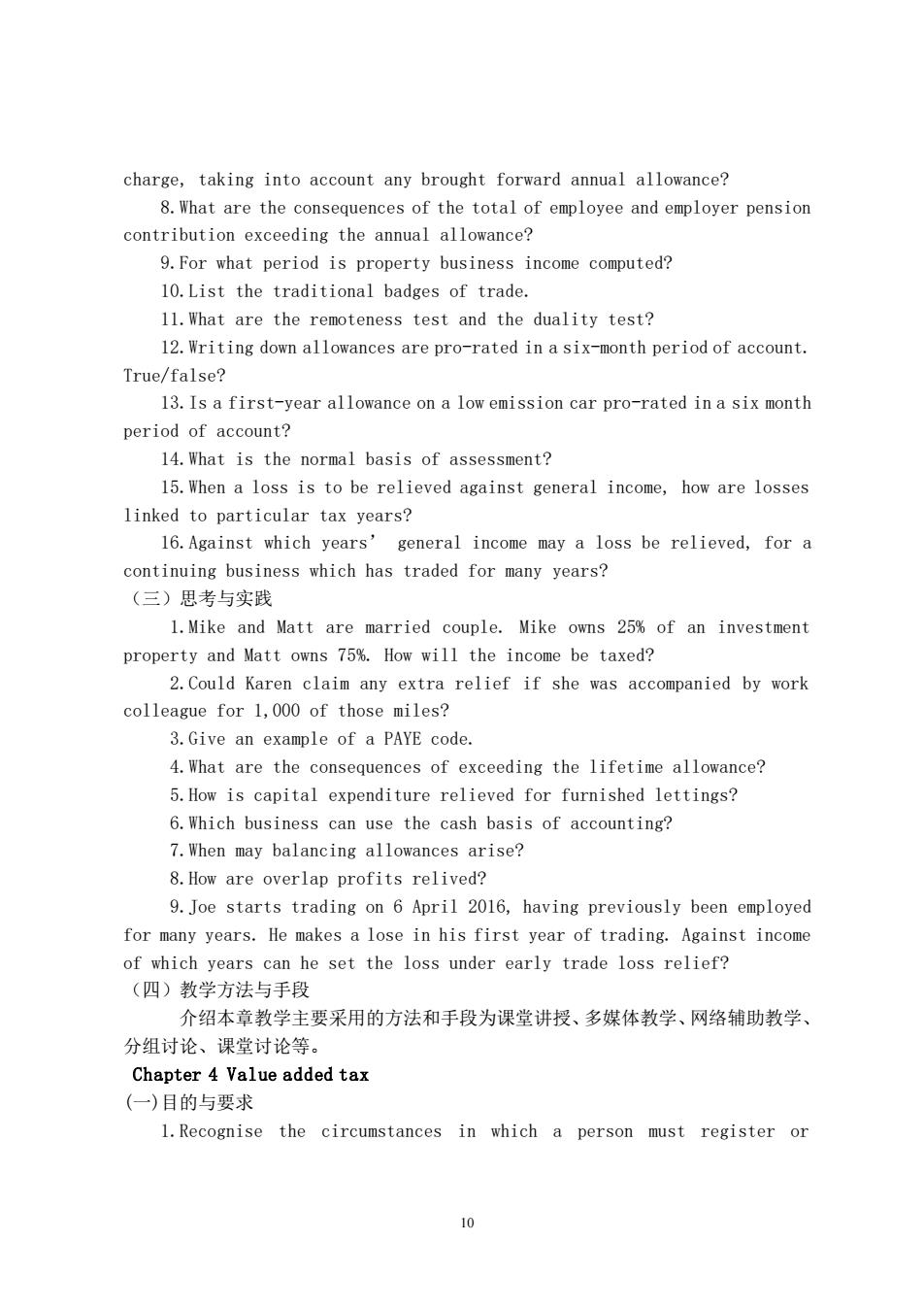
charge,taking into account any brought forward annual allowance? 8.What are the consequences of the total of employee and employer pension contribution exceeding the annual allowance? 9.For what period is property business income computed? 10.List the traditional badges of trade 11.What are the remoteness test and the duality test? 12.Writing down allowances are pro-rated in a six-month period of account. True/false? 13.Is a first-vear allowance on a low emission car pro-rated in a six month period of account? 14.What is the normal basis of assessment? 15.When a loss is to be relieved against general income,how are losses linked to particular tax years? 16.Against which years'general income may a loss be relieved,for a continuing business which has traded for many years? (三)思考与实践 1.Mike and Matt are married couple.Mike owns 25%of an investment property and Matt owns 75%.How will the income be taxed? 2.Could Karen claim any extra relief if she was accompanied by work colleague for 1,000 of those miles? 3.Give an example of a PAYE code. 4.What are the consequences of exceeding the lifetime allowance? 5.How is capital expenditure relieved for furnished lettings? 6.Which business can use the cash basis of accounting? 7.When may balancing allowances arise? 8.How are overlap profits relived? 9.Joe starts trading on 6 April 2016,having previously been employed for many vears.He makes a lose in his first vear of trading.Against income of which years can he set the loss under early trade loss relief? (四)教学方法与手段 介绍本章教学主要采用的方法和手段为课堂讲授、多媒体教学、网络辅助教学、 分组讨论、课堂讨论等。 Chapter 4 Value added tax (一)目的与要求 1.Recognise the circumstances in which a person must register or 10
10 charge, taking into account any brought forward annual allowance? 8.What are the consequences of the total of employee and employer pension contribution exceeding the annual allowance? 9.For what period is property business income computed? 10.List the traditional badges of trade. 11.What are the remoteness test and the duality test? 12.Writing down allowances are pro-rated in a six-month period of account. True/false? 13.Is a first-year allowance on a low emission car pro-rated in a six month period of account? 14.What is the normal basis of assessment? 15.When a loss is to be relieved against general income, how are losses linked to particular tax years? 16.Against which years’ general income may a loss be relieved, for a continuing business which has traded for many years? (三)思考与实践 1.Mike and Matt are married couple. Mike owns 25% of an investment property and Matt owns 75%. How will the income be taxed? 2.Could Karen claim any extra relief if she was accompanied by work colleague for 1,000 of those miles? 3.Give an example of a PAYE code. 4.What are the consequences of exceeding the lifetime allowance? 5.How is capital expenditure relieved for furnished lettings? 6.Which business can use the cash basis of accounting? 7.When may balancing allowances arise? 8.How are overlap profits relived? 9.Joe starts trading on 6 April 2016, having previously been employed for many years. He makes a lose in his first year of trading. Against income of which years can he set the loss under early trade loss relief? (四)教学方法与手段 介绍本章教学主要采用的方法和手段为课堂讲授、多媒体教学、网络辅助教学、 分组讨论、课堂讨论等。 Chapter 4 Value added tax (一)目的与要求 1.Recognise the circumstances in which a person must register or